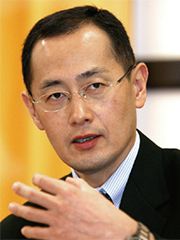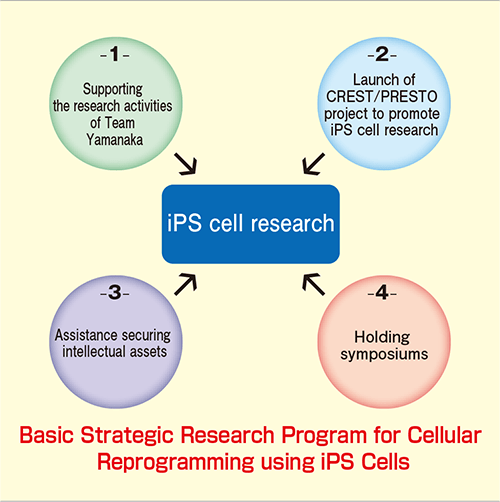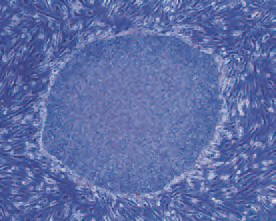Research Results
Expectations towards regenerative medicine and drug development
Establishing induced pluripotent stem (iPS) cells FY2016

- Shinya Yamanaka (Director, Center for iPS Cell Research and Application (CiRA), Kyoto University)
- CREST
- Translational Research for Intractable Immune Disorders and Infectious Diseases
"Generation of Ideal Pluripotent Stem Cells for Clinical Applications" Research Director (2003-2008) Yamanaka iPS Cell Project Research Director (2008-2012) - Core Center for iPS Cell Research
- "Center of Excellence in Development of iPS Cell Stock for Regenerative Medicine" Center Director (2013-)*
*This research project has been transferred to the Japan Agency for Medical Research and Development as of April 1, 2015.
Toward realization of regenerative medicine
On November 20, 2007, Professor Shinya Yamanaka announced in the journal Cell his discovery of the phenomenon of initialization of mature cells, which enabled them to acquire pluripotentiality. This announcement took the world by storm, bringing with it high expectations for clinical applications such as regenerative medicine and treating intractable diseases. In 2012, only 5 years later, in consideration of the discovery that shook the world in 2007, Professor Yamanaka was awarded the Nobel Prize in Physiology or Medicine.
The establishment of iPS cells overturned the previous conventional understanding̶that once differentiated, cells do not initialize again̶and has also overcome the various ethical problems surrounding the use of embryonic stem cells (ES cells). This discovery continues to spark innovation worldwide. Moreover, in September 2014, the project leader Masayo Takahashi and others at RIKEN performed the world's first clinical research of transplanting the pigment epithelium that derives from iPS cell to an exudative age-related macular degeneration patient.
Creating bones, hearts, nerves, livers, blood, etc., from skin cells!
iPS cells are induced pluripotent stem cells. Pluripotent stem cells have universal properties, and if properly cultivated, can be differentiated to grow into bones, hearts, nerves, livers, blood cells, and various other parts: all the cells that constitute the human body. Previously, it was unthinkable that the cells that constitute the skin etc. could ever become pluripotent stem cells. This is because returning cells to the same pluripotent state as fertilized ova seemed to represent nothing less than winding back the clock, like some kind of time machine.
However, by simply introduction of mere 4 genes into skin cells, Professor Yamanaka's team achieved the seemingly impossible task of winding back the clock.
Producing human iPS cells (*initial method)

Overcoming major barriers to regenerative medicine!
Given current medical treatment, the only existing medical procedure for organ failure is a transplant from another individual. However, organ transplants involve the inherent risk of rejection, and have also been chronic donor shortage. Since embryonic stem cells, which possess the same pluripotentiality universal properties as iPS cells, require the use of fertilized human ova, it has been argued that they are ethically problematic. Fertilized ova could be a cell represents the original mechanism for creating human life. It is a telling fact that in the USA, the creation of new embryonic human stem cells using public research funding was prohibited during the Bush administration.
iPS cells, which can be readily created from human skin cells, represent nothing less than one of the most significant discoveries of the century, and can become the solution to all these problems. After the announcement of iPS cell research, so crucial to humanity's long-held dream of regenerative medicine, JST quickly established the"Basic Strategic Research Program for Cellular Reprogramming using iPS Cells"to create an all-Japan research framework. Under this rubric, Japan supports iPS research in many different ways: hosting international symposia, launching the Yamanaka iPS Cell Project (based upon the 2008 Strategic Sector"Creating fundamental technologies for advanced medicine through generation and regulation of stem cells, based on cellular reprogramming"), mandating new CREST/PRESTO research areas, and more. Moreover Research Center Network for Realization of Generative Medicine has established in 2012 as a core center is supporting iPS cell research of stock of iPS generative medicine.

New Medical Treatments Made Possible Through iPS cells
The possibilities of iPS cells are far more wide-ranging than just regenerative medicine. Major results are also expected in the creation of new pharmaceuticals.
For example, by differentiating iPS cells into the various cells of tissues for patients with rare and intractable diseases of unknown causes, and then comparing these with normal healthy cells, it will be possible to diagnose these pathologies and develop effective pharmaceuticals. In cases where physical examination of tissue structure is not possible, such as with the heart or central nervous system, it is expected that these cells can be recreated using iPS cells and used to find out the cause of the medical condition. The discovery of iPS also seems likely to bring about an end to the previous necessity of animal experimentation conducted in the biological sciences.
Kyoto University has been granted patents relating to this basic iPS cell technology in many countries. Of these patents, the right for methods of establishing iPS cells extends to the use of the established iPS cells in medical treatments and drug development.
These influential patents owned by public institutions licensing widely an environment is created that fosters and enables the participation of many companies in iPS cell research and development, screening for candidate drug substances. We can expect that providing for curative medicine and medical cure by these companies enter into research and development for many people using iPS cell technology.
iPS cells derived from human skin cells

Provided by: Center for iPS Cell Research and Application
